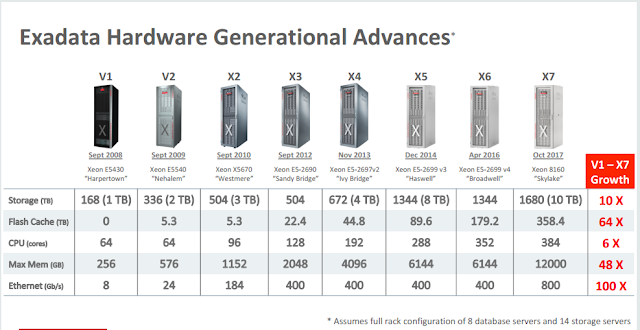First Oracle's exadata was released in 2008 known as hardware and software engineered to work together. Since than we have seen 6 release of exadata machine with improved the combination of hardware and software. Latest X5-2 released in 2015.
V1: The first Exadata was released in 2008 and labeled as V1. It was a combination of HP hardware and Oracle software. There were no flash cache used in this version. At that time Exadata was made specially for Data ware housing only. This product was not accepted widely as it was suffered from overheating.
V1: The first Exadata was released in 2008 and labeled as V1. It was a combination of HP hardware and Oracle software. There were no flash cache used in this version. At that time Exadata was made specially for Data ware housing only. This product was not accepted widely as it was suffered from overheating.
V2: After V1 Oracle has launched Exadata V2 in 2009. It was a combination of Sun hardware and Oracle software. Here in V2 Oracle has upgraded storage cell with 384 GB of Exadata smart cache. Many o the customer has changed the Exadata from V to V2 because of the overheating problem in Exadata V1.
X2: This is the third edition of Oracle Exadata released in 2010.There are two version X2-2 stands for dual core CPUs and X2-8 stands for 8 core CPUs database server. This version is supporting both OLTP and Data warehouse. Also this has massive features compare to older Exadata in terms of CPUs, Memory, Compression, Smart scan etc...
X3: This is the forth edition of Exadata released in 2012. There is no much more difference between X2 and X3 except in CPU and RAM. This version has more RAM and CPU power then the previous one.
X4: It was released in 2013. In this version processing was increased to 2×12 core CPUs. It had the capacity to upgrade memory to 512GB in a compute node. Flash and disk storage was also increased. It featured a new model of high-capacity disk. 600GB disks were retired, and included 1.2TB, 10,000 RPM disks. These disks were a smaller form factor (2.5” vs 3.5”). The other big change with the X4-2 was the introduction of an active/active InfiniBand network connection. On the X4-2, Oracle broke the bonded connection and utilized each InfiniBand port independently. This allowed an increased throughput across the InfiniBand fabric.
X5: It was announced in early 2015, the sixth generation of Exadata. The X5-2 was a dramatic change in the platform, removing the high-performance Disk option in favor of an all-flash, NVMe (Non-Volatile Memory Express) model. High-capacity disk sizes remain the same at 4TB per disk. The size of the flash cards doubled to 6.4TB per storage server. Memory stayed consistent with a base of 256GB, upgradeable to 768 GB, and the CPU core count increased to 18 cores per socket. With X5, customers are allowed to purchase X5-2 with any configuration required—a base rack begins with two compute nodes and three storage servers.
X4: It was released in 2013. In this version processing was increased to 2×12 core CPUs. It had the capacity to upgrade memory to 512GB in a compute node. Flash and disk storage was also increased. It featured a new model of high-capacity disk. 600GB disks were retired, and included 1.2TB, 10,000 RPM disks. These disks were a smaller form factor (2.5” vs 3.5”). The other big change with the X4-2 was the introduction of an active/active InfiniBand network connection. On the X4-2, Oracle broke the bonded connection and utilized each InfiniBand port independently. This allowed an increased throughput across the InfiniBand fabric.
X5: It was announced in early 2015, the sixth generation of Exadata. The X5-2 was a dramatic change in the platform, removing the high-performance Disk option in favor of an all-flash, NVMe (Non-Volatile Memory Express) model. High-capacity disk sizes remain the same at 4TB per disk. The size of the flash cards doubled to 6.4TB per storage server. Memory stayed consistent with a base of 256GB, upgradeable to 768 GB, and the CPU core count increased to 18 cores per socket. With X5, customers are allowed to purchase X5-2 with any configuration required—a base rack begins with two compute nodes and three storage servers.

No comments:
Post a Comment